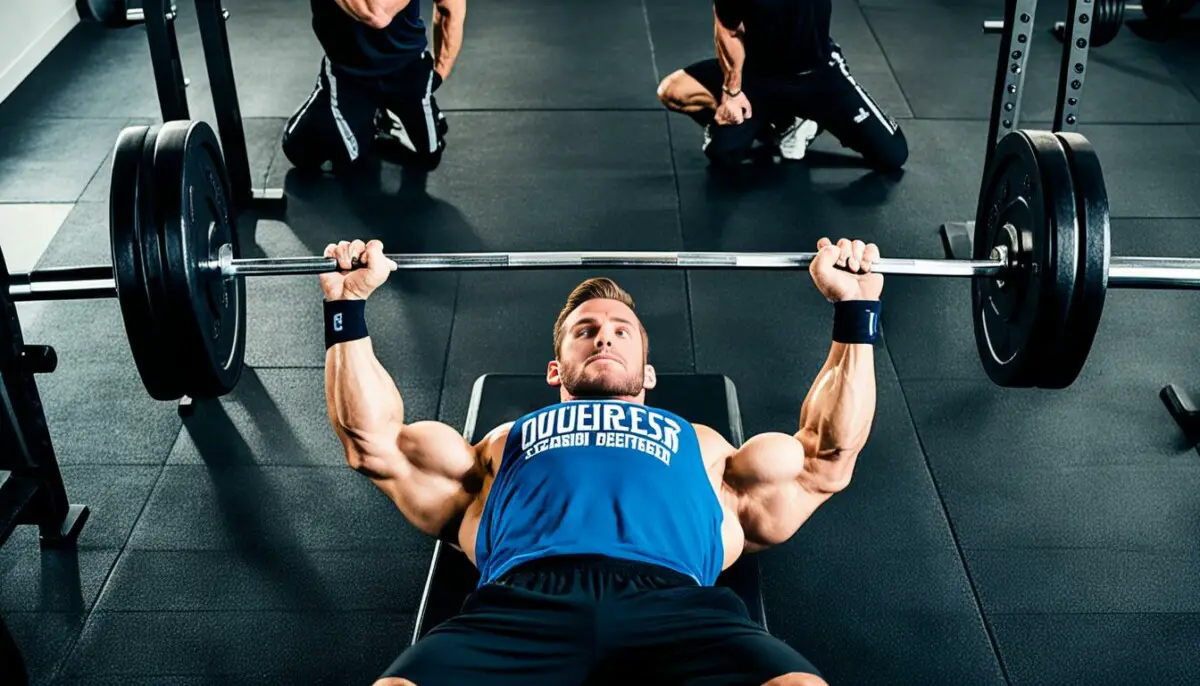Last Updated on 3 months by Francis
The bench press has long been seen as a benchmark for strength in the fitness world. While it is not the most accurate measure of overall strength, it remains a popular exercise for building upper body strength. There is no universal standard for how much weight a person should be able to bench press, as it depends on individual factors such as goals, fitness level, and training age. However, being able to bench press your body weight is considered a significant achievement for most people.
Contents
Key Takeaways:
- Bodyweight bench press is a significant achievement in strength training.
- Individual factors such as goals, fitness level, and training age determine bench press performance.
- Bench press is a popular exercise for building upper body strength.
How Much Weight Men Should Be Able to Bench Press

When it comes to bench press standards, there is no one-size-fits-all answer to how much weight a man should be able to lift. The amount varies depending on several factors such as individual goals, fitness level, and training age. However, there are some milestones that can be used as benchmarks for weightlifting achievements.
For beginners, a good goal is to be able to bench press at least half of their body weight. This serves as a starting point to build strength and establish a solid foundation. As experience and training age increase, the bench press weight can be further enhanced.
For lifters with 1 to 3 years of experience, a reasonable range is to be able to bench press between 1 to 1.25 times their body weight. This indicates steady progress and demonstrates an increased level of strength and fitness.
For seasoned lifters with 3-plus years of experience, the bench press weight can range from 1.5 times to double their body weight. This reflects a high level of proficiency in weightlifting and showcases remarkable strength.
It is important to note that these are general guidelines and can vary based on individual circumstances. All fitness goals should be tailored to personal needs and capabilities. It’s essential to focus on gradual improvement while considering safety and proper form.
The Importance of Setting Fitness Goals
Setting fitness goals is vital for both motivation and personal growth. Bench press goals serve as milestones to strive for, keeping individuals accountable and focused on their weightlifting journey. Whether it’s aiming to reach a specific weight or achieve a higher level of strength, having clear fitness goals provides direction and purpose.
“Setting realistic and achievable goals is key. It allows you to track your progress, celebrate small victories, and maintain long-term motivation.” – Fitness Expert
By setting specific goals, individuals can better assess their progress and make adjustments to their training program as needed. It’s important to remember that no goal is too big or too small. By consistently working towards their desired bench press goals, individuals can experience not only physical improvements but also a sense of accomplishment and pride in their weightlifting achievements.
Tracking Progress: Celebrating Milestones
In addition to setting goals, tracking progress and celebrating milestones are essential components of a successful weightlifting journey. Regularly measuring and recording bench press achievements can provide valuable insight into individual growth and help individuals stay motivated.
One effective way to track progress is by maintaining a workout log or using a fitness app. These tools allow individuals to record their bench press performances, including the weight lifted, reps completed, and any other relevant notes. By reviewing this data over time, individuals can observe their improvements and identify areas where further focus is needed.
In celebration of milestones, it’s crucial to acknowledge personal achievements and acknowledge the hard work and dedication put into reaching each goal. Rewarding oneself with small incentives or sharing accomplishments with a supportive community can provide a sense of validation and serve as a source of inspiration for future weightlifting endeavors.
Summary
When it comes to determining how much weight a man should be able to bench press, there is no universal standard. It varies based on individual factors such as goals, fitness level, and training age. However, using benchmarks as a guide can help individuals set realistic targets and track their progress on their weightlifting journey.
How to Increase Your Bench Press

When it comes to increasing your bench press, progressive overload is key. This involves gradually increasing the amount of weight you lift over time, challenging your muscles to adapt and grow stronger.
To complement your bench press routine and improve overall upper body strength, it’s important to incorporate exercises that target the chest, shoulders, and triceps. Some effective exercises include:
- Dumbbell bench press
- Incline bench press
- Push-ups
- Dips
- Shoulder presses
Consistency is essential for progress. Make sure to stick to your training schedule and allow for adequate rest and recovery between workouts to give your muscles the time they need to repair and grow.
Varying your repetition schemes can also contribute to bench press improvement. Incorporate different rep ranges, such as low reps (1-5) for strength gains and higher reps (8-12) for muscle hypertrophy.
Don’t be afraid to bench press more than once a week. Increasing the frequency can help you practice the movement pattern and build more muscle mass.
Identifying and working through sticking points is another effective strategy for bench press improvement. Sticking points are areas in the lift where you struggle the most. By targeting these weak points with specific accessory exercises or techniques, you can overcome them and progress further.
Remember, increasing your bench press requires patience, dedication, and consistency. Keep pushing yourself and celebrate each small victory along the way.
“The bench press is a classic exercise for building upper body strength, but to make real progress, you need to continuously challenge yourself and incorporate targeted exercises to improve your overall muscle strength.”
Bench Press Average by Weight and Age

Bench press averages can vary based on body weight and age. Generally, men will lift heavier loads than women. For men, the average untrained individual can bench press around 85 pounds for a body weight of 114 pounds, while an advanced or elite athlete can lift more than twice their body weight. For women, the average untrained individual can bench press around 50 pounds for a body weight of 97 pounds, while an advanced or elite athlete can lift 1.3 times their body weight.
These averages can serve as a guide for setting personal goals and tracking progress. Whether you’re a beginner or an experienced lifter, understanding your starting point in relation to these benchmarks can help inform your training program and provide a realistic framework for improvement. Keep in mind that these numbers are general averages, and individual performance can vary based on factors such as genetics, training history, and overall fitness level.
Bench Press Averages by Weight and Age
| Weight | Average Untrained Individual (Men) | Advanced/Elite Athlete (Men) | Average Untrained Individual (Women) | Advanced/Elite Athlete (Women) |
|---|---|---|---|---|
| 114 lbs | 85 lbs | 2x body weight | N/A | N/A |
| 150 lbs | 110 lbs | 2.8x body weight | N/A | N/A |
| 180 lbs | 135 lbs | 3x body weight | N/A | N/A |
| 200 lbs | 150 lbs | 3.5x body weight | N/A | N/A |
| 97 lbs | N/A | N/A | 50 lbs | 1.3x body weight |
| 130 lbs | N/A | N/A | 65 lbs | 1.7x body weight |
| 150 lbs | N/A | N/A | 75 lbs | 2x body weight |
| 170 lbs | N/A | N/A | 85 lbs | 2.2x body weight |
Remember, these figures are just averages, and individual performance can vary. The most important thing is to focus on improving your own strength and fitness level, rather than comparing yourself to others. With consistent training and proper progression, you can work towards surpassing these benchmarks and achieving your personal fitness goals.
How to Get Stronger with Bench Pressing

To improve your strength in bench pressing, it is crucial to focus on key principles such as progressive overload, proper technique, and incorporating accessory exercises. By following these strategies, you can gradually increase your strength, achieve weightlifting achievements, and enhance your muscle strength.
- Progressive overload: To continually challenge your muscles and promote muscle strength gains, regularly increase the amount of weight, reps, or sets you lift during bench press workouts. Start with a weight that challenges you but allows for proper form and gradually add more weight as you progress.
- Proper technique: Maintaining proper form during bench pressing not only maximizes the effectiveness of the exercise but also reduces the risk of injury. Focus on maintaining a stable grip and hand position, proper shoulder placement, and a controlled back arch. Breathe properly during the exercise and engage your core for stability.
- Accessory exercises: Incorporating exercises that target the chest, shoulders, and triceps can help improve overall strength for bench pressing. Some effective accessory exercises include incline bench press, dumbbell chest flyes, shoulder presses, and tricep dips. These exercises will help strengthen the supporting muscles, allowing you to lift more weight during bench press.
- Proper nutrition and rest: A balanced diet that supports muscle growth, repair, and recovery is essential for getting stronger with bench pressing. Consume adequate protein to fuel muscle growth and incorporate nutritious foods to support overall health and performance. Additionally, ensure you give your muscles adequate rest and recovery time between workouts to optimize strength gains.
By following these guidelines, you can develop a solid foundation for strength training, achieve weightlifting achievements, enhance muscle strength, and work towards reaching your fitness goals.
Example Bench Press Strength Training Program
Here is an example of a bench press strength training program that incorporates the principles mentioned above:
| Exercise | Sets x Reps | Weight |
|---|---|---|
| Bench Press | 4 x 6-8 | 70% of 1-rep max (RM) |
| Incline Barbell Press | 3 x 8-10 | 60% of 1-RM |
| Standing Military Press | 3 x 10-12 | 50% of 1-RM |
| Tricep Dips | 3 x 10-12 | Body weight or added resistance |
| Push-ups | 3 x 12-15 | Body weight |
Note: The weight percentages provided are for illustrative purposes and may vary based on individual strength levels. Adjust the weight, sets, and reps to suit your fitness level and goals.
By incorporating progressive overload, maintaining proper technique, and including accessory exercises, you can improve your bench press strength, achieve weightlifting accomplishments, and enhance overall muscle strength.
Bench Press Alternatives and Variations

While the barbell bench press is a popular exercise for building upper body strength, it may not be suitable for everyone. Fortunately, there are alternative exercises and variations that can still help develop chest, shoulder, and tricep strength. Some options include:
- Dumbbell Bench Press: This exercise targets the same muscles as the barbell bench press but allows for greater range of motion and increased stabilization. It can be done with body weight or with added resistance.
- Machine Chest Press: Using a chest press machine can provide a controlled and stable environment for chest and tricep activation. This exercise is especially beneficial for beginners or those with limited mobility.
- Push-Ups: Push-ups are a classic bodyweight exercise that targets the chest, shoulders, and triceps. They can be modified to increase or decrease intensity based on fitness level.
By incorporating these exercises into your routine, you can still achieve the benefits of the bench press while using different equipment or leveraging your own body weight. Choose exercises that are comfortable for you and provide the desired muscle activation. Variating your workouts can also help prevent muscle adaptation and boredom, keeping your fitness journey exciting and challenging.
For a visual reference on how to perform these exercises, refer to the image below:
| Exercise | Sets | Reps | Rest |
|---|---|---|---|
| Dumbbell Bench Press | 3 | 8-12 | 60 seconds |
| Machine Chest Press | 3 | 10-15 | 60 seconds |
| Push-Ups | 3 | 15-20 | 60 seconds |
Remember to warm up before each workout and gradually increase the intensity and weight as you become stronger. Listen to your body and modify the exercises as needed to avoid any discomfort or strain. By incorporating these bench press alternatives into your fitness routine, you can continue to develop muscle strength and achieve your bodyweight fitness goals.
How to Set Bench Press Goals
Setting bench press goals is crucial for progress and motivation in your strength training journey. By establishing clear objectives, you can focus your efforts and track your achievements. Here are some tips to help you set effective bench press goals:
- Make your goals realistic: Set goals that are challenging but achievable within a reasonable timeframe. Consider your current fitness level, experience, and any limitations you may have.
- Personalize your goals: Tailor your objectives to your preferences, interests, and desired outcomes. Whether you aim to increase your one-rep max, improve muscular endurance, or enhance overall strength, ensure your goals align with your fitness aspirations.
- Consult a professional: Working with a qualified trainer or fitness professional can provide invaluable guidance. They can assess your current abilities, design a personalized program, and offer expert advice on proper technique, progression, and injury prevention.
- Consider individual factors: Take into account your age, gender, and training experience when setting bench press goals. These factors can influence your starting point and the rate at which you can progress. Remember that everyone’s journey is unique, so avoid comparing yourself to others.
- Track your progress: Monitor your performance and celebrate your milestones along the way. Keeping a record of your bench press weights, sets, and reps can provide a clear picture of your progress over time, boosting motivation and helping you identify areas for improvement.
Remember, bench press goals should be specific, measurable, attainable, relevant, and time-bound (SMART). Keep challenging yourself, stay consistent in your training, and be patient with your progress. With dedication and perseverance, you can achieve your desired bench press achievements and surpass your fitness goals.
Proper Bench Press Technique and Form
Proper technique and form are essential for maximizing the effectiveness and safety of the bench press. Whether you’re engaged in strength training or weightlifting, mastering the correct exercise form is crucial. By following these guidelines, you can optimize your bench press performance and minimize the risk of injuries.
Grip Width
One of the key aspects of bench press technique is determining the optimal grip width. Place your hands on the barbell slightly wider than shoulder-width apart. This grip allows for proper engagement of the chest, shoulders, and triceps during the exercise. Avoid gripping the barbell too wide, as it may strain the shoulder joints, or too narrow, which limits your range of motion.
Hand Position
Position your hands in a way that feels comfortable and secure. Your palms should be facing forward, and your wrists should be in a neutral position. This grip helps maintain stability and control throughout the movement.
Shoulder Placement
Before initiating the bench press, retract your shoulder blades and bring them down, creating a stable and solid foundation. This position not only enhances your strength but also safeguards your shoulders from unnecessary stress.
Back Arch
Creating a slight arch in your lower back helps maintain proper spinal alignment during the bench press. However, be cautious not to over-arch or lift your buttocks off the bench, as this compromises stability and may result in reduced force production.
Breathing and Stabilization Techniques
Proper breathing and stabilization techniques play a vital role in executing the bench press correctly. Take a deep breath before lowering the barbell, then exhale forcefully as you exert effort to push it back up. Engage your core muscles throughout the movement to enhance stability and transfer power effectively.
Starting with Lighter Weight
If you’re new to bench pressing or refining your technique, it’s recommended to start with a lighter weight. This allows you to focus on mastering proper form before gradually increasing the load. Remember, strength and technique go hand in hand, and it’s crucial to prioritize form over weight lifted.
Conclusion
The bench press is a popular exercise for building upper body strength and is often used as a benchmark for strength. However, the amount of weight a person can bench press varies based on individual factors such as goals, fitness level, and training age. Whether you’re a beginner or an experienced lifter, setting realistic goals and focusing on progressive overload can help you improve your bench press performance.
Proper technique and form are crucial when performing the bench press. It’s important to maintain a stable base, engage your core, and use the appropriate grip width and hand position. Working with a knowledgeable trainer or fitness professional can help you develop the right technique and prevent injuries.
Remember that strength training takes time and consistency. It’s important to listen to your body, rest and recover adequately, and seek guidance from professionals when needed. By staying dedicated and following a structured training program, you can work towards achieving your desired bench press goals and make significant weightlifting achievements.
FAQ
Can You Bench Your Bodyweight? Find Out How Many Can
The ability to bench press your body weight is considered a significant achievement for most people. However, there is no universal standard for how much weight a person should be able to bench press, as it depends on individual factors such as goals, fitness level, and training age.
How Much Weight Men Should Be Able to Bench Press
There is no one-size-fits-all answer to how much weight a man should be able to bench press. It varies depending on factors such as goals, fitness level, and training age. However, benchmarks can be used as goals. For beginners, being able to bench press at least half of their body weight is a good goal. As experience and training age increase, the bench press weight can range from 1 to 1.25 times body weight for lifters with 1 to 3 years of experience, and 1.5 times to double body weight for lifters with 3-plus years of experience.
How to Increase Your Bench Press
The key to increasing your bench press is progressive overload, which means gradually increasing the amount of weight you lift over time. Additionally, incorporating other exercises that target the chest, shoulders, and triceps can help improve overall upper body strength. It is important to be consistent with your training and allow for adequate rest and recovery between workouts. Varying rep schemes, benching more than once per week, and working through sticking points can also contribute to bench press improvement.
Bench Press Average by Weight and Age
Bench press averages can vary based on body weight and age. Generally, men will lift heavier loads than women. For men, the average untrained individual can bench press around 85 pounds for a body weight of 114 pounds, while an advanced or elite athlete can lift more than twice their body weight. For women, the average untrained individual can bench press around 50 pounds for a body weight of 97 pounds, while an advanced or elite athlete can lift 1.3 times their body weight.
How to Get Stronger with Bench Pressing
To get stronger in bench pressing, it is important to focus on progressive overload and consistently challenge your muscles. This means gradually increasing the amount of weight, reps, or sets over time. Proper form and technique are crucial to ensure maximum effectiveness and reduce the risk of injury. Additionally, incorporating accessory exercises that target the chest, shoulders, and triceps can help improve overall strength. It is also important to have a balanced diet and adequate rest for proper muscle recovery and growth.
Bench Press Alternatives and Variations
While the barbell bench press is a popular exercise for building upper body strength, there are alternative exercises and variations that can still help develop chest, shoulder, and tricep strength. Some options include dumbbell bench press, machine chest press, and push-ups. These exercises can be performed with bodyweight or with added resistance. It is important to choose exercises that are comfortable and provide the desired muscle activation.
How to Set Bench Press Goals
Setting bench press goals is an important part of progress and motivation. Goals should be realistic, achievable, and tailored to individual preferences and fitness levels. Factors such as age, gender, and experience level should also be taken into consideration when setting goals. It is helpful to work with a trainer or fitness professional to develop a program that is specific to your needs and provides guidance on technique and progression. Tracking progress and celebrating milestones can also help keep motivation high.
Proper Bench Press Technique and Form
Proper technique and form are essential for maximizing the effectiveness and safety of the bench press. This includes proper grip width, hand position, shoulder placement, and back arch. Breathing and stabilization techniques are also important for maintaining control and preventing injury. It is recommended to start with a lighter weight and focus on mastering proper form before increasing the load. Working with a knowledgeable trainer or fitness professional can help ensure correct technique and prevent potential injuries.
Conclusion
The bench press is a popular exercise for building upper body strength and is often used as a benchmark for strength. However, the amount of weight a person can bench press varies based on individual factors such as goals, fitness level, and training age. Setting realistic goals, focusing on progressive overload, and maintaining proper technique are key to improving bench press performance. It is important to listen to your body, rest and recover adequately, and seek guidance from professionals when needed. With consistency and dedication, anyone can work towards achieving their desired bench press goals.





.jpg)


